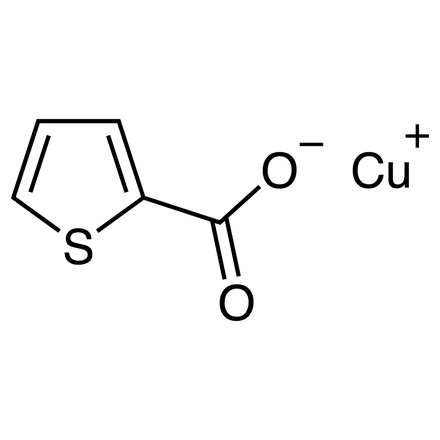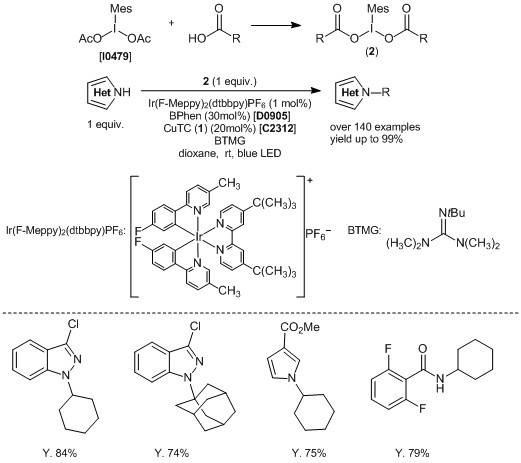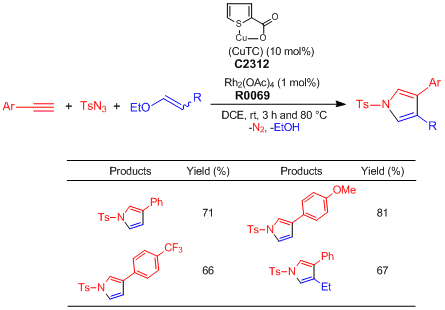Published TCIMAIL newest issue No.197
Maximum quantity allowed is 999
Bitte wählen Sie die Menge aus.
CAS RN: 68986-76-5 | Produkte #: C2312
Copper(I) 2-Thiophenecarboxylate

Reinheit:
Synonyme
- 2-Thiophenecarboxylic Acid Copper(I) Salt
- (2-Thiophenecarboxylato)copper(I)
- CuTC
Produktdokumente:
| Einheit | Stückpreis | Belgien | Japan* | Menge |
|---|---|---|---|---|
| 1G |
€30.00
|
4 | ≥80 |
|
| 5G |
€105.00
|
2 | ≥80 |
|
*In Belgien verfügbare Lagerbestände werden in 1 bis 3 Tagen geliefert.
*In Japan verfügbare Lagerbestände werden in 1 bis 2 Wochen geliefert. (unter Ausschluss von regulierten Artikeln und Trockeneislieferungen).
| Artikel # | C2312 |
| Summenformel / Molekülmasse | C__5H__3CuO__2S = 190.68 |
| Physikalischer Zustand (20 °C) | Solid |
| Lagerungstemperatur | Room Temperature (Recommended in a cool and dark place, <15°C) |
| Unter Inertgas lagern | Store under inert gas |
| Zu vermeidende Bedingungen | Moisture Sensitive |
| Verpackung und Behälter | 1G-Glass Bottle with Plastic Insert (Bild ansehen) |
| CAS RN | 68986-76-5 |
| PubChem-Stoff-ID | 253660329 |
| Merck-Index (14) | 2521 |
| MDL-Nummer | MFCD02183524 |
Spezifikation
| Appearance | Orange to Brown to Dark red powder to crystal |
| Elemental analysis(Carbon) | 25.00 to 35.00 % |
| Content(Copper) | 30.0 to 40.0 % |
Eigenschaften
GHS
| Piktogramm |

|
| Signalwort | Achtung |
| Gefahrenhinweise | H315 : Verursacht Hautreizungen. H319 : Verursacht schwere Augenreizung. |
| Sicherheitshinweise | P264 : Nach Gebrauch Haut gründlich waschen. P280 : Schutzhandschuhe/ Augenschutz/ Gesichtsschutz tragen. P302 + P352 : BEI BERÜHRUNG MIT DER HAUT: Mit viel Wasser waschen. P337 + P313 : Bei anhaltender Augenreizung: Ärztlichen Rat einholen/ ärztliche Hilfe hinzuziehen. P362 + P364 : Kontaminierte Kleidung ausziehen und vor erneutem Tragen waschen. P332 + P313 : Bei Hautreizung: Ärztlichen Rat einholen/ ärztliche Hilfe hinzuziehen. |
Verwandte Gesetze:
Transportinformationen:
| HS-Nr. (Import / Export) (TCI-E) | 2934999090 |
Anwendung
Copper/photoredox-catalyzed Decarboxylative sp3 C–N Coupling Reaction of N-Heteroaromatics

Preparation of Iodomesitylene Dicarboxylates: Iodomesitylene diacetate (10 mmol), cyclohexyl carboxylic acid (20.5 mmol), and toluene (200 mL) are placed in flask. The solvent is removed by a rotary evaporator at 55 °C. This step is repeated with toluene (100 mL) as needed. The residue is concentrated in vacuo, to provide iodomesitylene dicarboxylates that can be directly used in the decarboxylative sp3 C–N coupling reactions without further purification. sp3 C–N Coupling Reaction: Ir(F-Meppy)2(dtbbpy)PF6 (4.9 mg, 5.0 µmol), copper(I) 2-Thiophenecarboxylate (19 mg, 0.10 mmol), bathophenanthroline (50 mg, 0.15 mmol), 2-tert-butyl-1,1,3,3-tetramethylguanidine (0.21 mL, 171 mg, 1.0 mmol), 3-chloro-1H-indazole (76 mg, 0.50 mmol), iodomesitylene dicyclohexanecarboxylate (500 mg, 1.0 mmol), and 1,4-dioxane(12 mL) is placed in vial. The solution is sonicated until it becomes homogeneous and is then degassed with nitrogen. The reaction is stirred and irradiated using two 34-W blue LED lamps for 1 h. After the reaction has completed, the reaction mixture is diluted with water and EtOAc. The aqueous layer is extracted with EtOAc. The combined organic layers are washed with brine, dried over Na2SO4, filtered and concentrated in vacuo. The residue is purified by flash chromatography (30:1 hexane/EtOAc) on silica gel to afford the title compound (99 mg, 84% yield, >20:1 r.r.) as a colorless oil.
References
- Decarboxylative sp3 C–N coupling via dual copper and photoredox catalysis
Anwendung
Copper (I) Complex Promoting Various Coupling Reactions

References
- 1)G. D. Allred, L. S. Liebeskind, J. Am. Chem. Soc. 1996, 118, 2748.

- 2)S. Zhang, D. Zhang, L. S. Liebeskind, J. Org. Chem. 1997, 62, 2312.

- 3)L. S. Liebeskind, J. Srogl, J. Am. Chem. Soc. 2000, 122, 11260.

Anwendung
One-pot Synthesis of Pyrroles from Terminal Alkynes, N-Sulfonyl Azides, and Alkenyl Alkyl Ethers

Typical Procedure:
Alkyne (0.2 mmol), TsN3 (1.0 eq.), alkenyl alkyl ether (3.0 eq.), CuTC (10.0 mol%), Rh2(OAc)4 (1.0 mol%), and DCE (0.2 M) are added to an oven-dried test tube under nitrogen atmosphere. The reaction mixture is stirred at ambient temperature for 3 h and then, heated at 80 °C for 4–13 h. After the reaction mixture is filtered through short path of celite with CH2Cl2, the filtrate is concentrated under reduced pressure. The residue is purified by silica gel column chromatography (ethyl acetate–hexane) to give pyrrole derivatives (Y. 65–81%).
Alkyne (0.2 mmol), TsN3 (1.0 eq.), alkenyl alkyl ether (3.0 eq.), CuTC (10.0 mol%), Rh2(OAc)4 (1.0 mol%), and DCE (0.2 M) are added to an oven-dried test tube under nitrogen atmosphere. The reaction mixture is stirred at ambient temperature for 3 h and then, heated at 80 °C for 4–13 h. After the reaction mixture is filtered through short path of celite with CH2Cl2, the filtrate is concentrated under reduced pressure. The residue is purified by silica gel column chromatography (ethyl acetate–hexane) to give pyrrole derivatives (Y. 65–81%).
References
PubMed Literatur
Artikel / Broschüren
TCIMail
[TCIMAIL No.166] Useful Copper Reagent for Coupling Reactions[Product Highlights] Copper/photoredox-catalyzed Decarboxylative sp3 C–N Coupling Reaction of N-Heteroaromatics
[Product Highlights] Copper (I) Complex Promoting Various Coupling Reactions
[Research Articles] One-pot Synthesis of Pyrroles from Terminal Alkynes, N-Sulfonyl Azides, and Alkenyl Alkyl Ethers
Produktdokumente (Hinweis: Für einige Produkte sind keine Analysediagramme verfügbar.)
Sicherheitsdatenblatt (SDB)
Bitte wählen Sie Sprache.
Das angeforderte SDB ist nicht verfügbar.
Bitte Kontaktieren Sie uns für mehr Informationen.
Spezifikationsdokumenten
AZ & andere Zertifikate
Bitte geben Sie die Lotnummer ein
Falsche Chargennummer wurde eingegeben. Bitte geben Sie nur 4-5 alphanumerische Zeichen vor dem Bindestrich ein.
Muster-AZ
Dies ist ein Muster-AZ und repräsentiert möglicherweise nicht eine kürzlich hergestellte Charge des Produkts.
Ein Muster-AZ für dieses Produkt ist zur Zeit nicht verfügbar.
Analytische Diagramme
Bitte geben Sie die Lotnummer ein
Falsche Chargennummer wurde eingegeben. Bitte geben Sie nur 4-5 alphanumerische Zeichen vor dem Bindestrich ein.
Das angeforderte Analysediagramm ist nicht verfügbar. Wir entschuldigen uns für die Unannehmlichkeiten.





